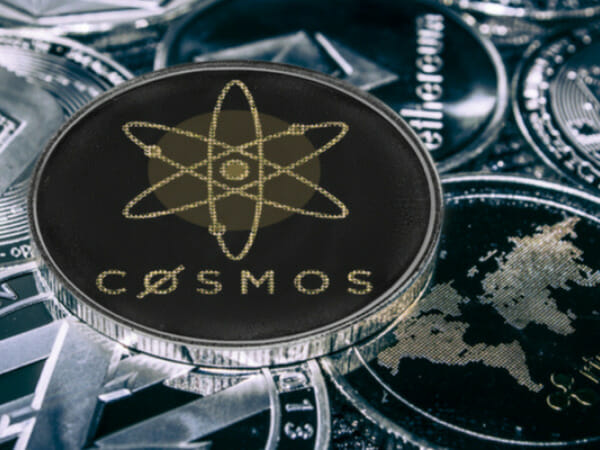Cosmos crypto network – all about the ‘Internet of Blockchains’
The Cosmos crypto network aims to bring all other cryptocurrencies together on the Internet of Blockchains. This will allow them to work well with each other, making it easier to use. In turn, it could bring more people to use the tech, further spreading cryptos adoption across the world. Can Cosmos achieve this lofty goal?
If you’ve been following crypto news long enough, you may have seen similar claims in other cryptos. We could throw all the buzzwords in, but what matters is how it’s used right now. Meanwhile, investors are more focused on what the Cosmos price will be in the long run. Most of them just want to know if it will skyrocket and send their portfolio to the moon!
We have to explain what Cosmos (ATOM) is first, and then we will go through the benefits and risks of this network. You will need to read these even though you just want to earn money from ATOMs. After all, these will help you decide if it’s a good investment or not. We will also throw in other options similar to Cosmos, so you can build a better portfolio.
What is Cosmos (ATOM)?

This one was founded by Jae Kwon in March 2019, and it aims to create an “internet of blockchains.” Those are the networks behind all cryptocurrencies.
It connects them using the Inter-Blockchain Communication protocol. This uses grouping systems called Zones and Hubs. The former are groups of blockchains that work differently from one another.
These Zones link to one another using the Hubs. When a Zone connects with Hub, it can access the other Zones linked to it. This speeds up the networks and prevents double-spending.
More importantly, this system organizes the Cosmos ecosystem. Its goal is to connect all the crypto networks, so it will need a way to make sense of all those connections.
The Cosmos crypto dream isn’t just to gather all the networks into one. It also gives people the tools they need to create new blockchains by themselves.
It’s made possible with the Tendermint BFT and the Cosmos SDK. Let’s start with the former. BFT stands for Byzantine Fault Tolerance, and you’ll see this protocol in other coins like NEO.
It allows the network to keep running even if parts of it break down. Yet, the Tendermint BFT sets itself apart by helping people develop blockchains faster.
Meanwhile, the Cosmos Software Development Kit (SDK) assists in speeding up blockchain development. This will let people add to the Cosmos Hub.
This is where all the Hubs and Zones meet up. As it gets new networks, it grows as a larger Cosmos network. Its main crypto token is ATOM, but it aims to support more tokens soon.
At the time of writing, the ATOM price was $36.02 and hit an all-time high of $44.70 on September 20. The circulating supply was 281,987,685 ATOM and the market cap was $10,157,413,359.
Read More: How The Internet Will Change With Web 3.0
What makes the Cosmos crypto network great?
The Cosmos network wants to connect independent blockchains. This may solve a major problem with cryptocurrencies and blockchains: they’re complicated!
It’s already challenging to study crypto networks, but making them work together is more difficult. Some of them are just not designed to interact with others.
The Cosmos crypto network will turn cryptocurrencies into a cohesive system that is much easier to use. What’s more, it doesn’t have to give up speed to do this.
Cosmos has a proof-of-stake system that allows more than a thousand transactions per second. Speaking of staking, you can set aside ATOM tokens to earn more as passive income.
What are the issues with the Cosmos crypto?
If you were hoping to make money from staking Cosmos, we have bad news. Contrary to popular belief, it’s not made for providing a passive cash flow.
Most people are usually drawn to the annual reward yield of roughly 10.28%. Based on that number alone, you may assume this is easy money.
Staking on the Cosmos crypto network is intended to protect your ATOMs against inflation. It increases the token supply which lowers their value.
If you stake ATOMs, it just makes sure the value doesn’t move. You won’t lose much money, but you won’t gain either. On the other hand, it’s worse if you just hold ATOM tokens.
Some people HODL (hold on for dear life) cryptocurrencies in the hopes of it rising in value in the future. That’s not a good idea if your token’s value drops due to increasing supply.
Worse, other cryptos work similarly, but they’re better in various ways. The biggest example is Polkadot (DOT) as it also lets people make blockchains themselves.
The DOT network lets people make parachains, blockchains that are connected via the Relay Chain. Those can have various functions and separate tokens.
What’s more, it uses the Kusama blockchain to test new upgrades before applying them on the DOT network. Similarly, Cosmos is building a testing blockchain called Sagan.
As you can see, this makes it hard for people to choose the Cosmos crypto network over other cryptos. You may want to check other crypto market options like:
Cosmos crypto alternatives
The core dev teams building upon The Graph are preparing to support the @cosmos ecosystem, a decentralized network of independent, interconnected blockchains. This integration is being led by the @figment_io team! 👨🚀
What will this mean for The Graph? 🧵⬇️ pic.twitter.com/YwBuS93gtg
— The Graph (@graphprotocol) November 5, 2021
- Decentraland (MANA) – It’s a network that lets people create digital real estate and make money from it. Facebook CEO Mark Zuckerberg stirred buzz around the Metaverse after renaming his company as Meta. As a result, the price of MANA tokens increased recently.
- The Graph (GRT) – The Cosmos crypto network may connect all the networks, but it needs a faster way to access data. Fortunately, The Graph Twitter page announced its support for Cosmos. Click here to learn more about GRT tokens.
- Avalanche (AVAX) – Decentralized apps (dapps) are like regular ones, but they have extra blockchain features. Avalanche helps people make dapps while letting existing ones from Ethereum into its network.
- Ethereum (ETH) – For the longest time, this has been in 2nd place on the crypto list. After all, it’s the number one choice for non-fungible tokens (NFTs) and smart contracts. What’s more, a lot of the more recent cryptos are built on the ETH network.
Related Articles
Final thoughts
This article is just for informational purposes, not financial advice. You’re in charge of planning your investments, so study the assets yourself.
Look for the ones that fit your short-term and long-term goals. Remember that risk is always a part of any investment. Never use the money you’re not willing to lose.
For more crypto updates, check the other Inquirer USA articles. They provide an overview of some of the trending coins. If you like stocks or bonds more, they have you covered too!
Sponsored Advertising Content:
Advertorial or Sponsorship User published Content does not represent the views of the Company or any individual associated with the Company, and we do not control this Content. In no event shall you represent or suggest, directly or indirectly, the Company's endorsement of user published Content.
The company does not vouch for the accuracy or credibility of any user published Content on our Website and does not take any responsibility or assume any liability for any actions you may take as a result of reading user published Content on our Website.
Through your use of the Website and Services, you may be exposed to Content that you may find offensive, objectionable, harmful, inaccurate, or deceptive.
By using our Website, you assume all associated risks.This Website contains hyperlinks to other websites controlled by third parties. These links are provided solely as a convenience to you and do not imply endorsement by the Company of, or any affiliation with, or endorsement by, the owner of the linked website.
Company is not responsible for the contents or use of any linked website, or any consequence of making the link.
This content is provided by New Start Advantage LLC through a licensed media partnership with Inquirer.net. Inquirer.net does not endorse or verify partner content. All information is for educational purposes only and does not constitute financial advice. Offers and terms may change without notice.



